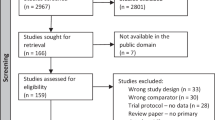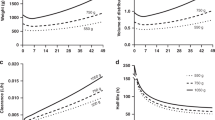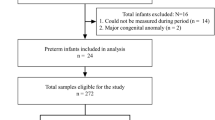Abstract
Background
Caffeine promotes spontaneous breathing by antagonizing adenosine. We assessed the direct effect of caffeine on respiratory effort in preterm infants at birth.
Methods
Thirty infants of 24–30 weeks of gestation were randomized for receiving caffeine directly after birth in the delivery room (caffeine DR group) or later in the neonatal intensive care unit (control group). Primary outcome was respiratory effort, expressed as minute volume, tidal volumes, respiratory rate, rate of rise to maximum tidal volume, and recruitment breaths at 7–9 min after birth.
Results
After correction for gestational age, minute volumes ((mean±SD; 189±74 vs. 162±70 ml/kg/min; P<0.05) and tidal volumes ((median (interquartile range (IQR)) 5.2 (3.9–6.4) vs. 4.4 (3.0–5.6) ml/kg) were significantly greater in the caffeine DR group. Although respiratory rates were similar ((mean±SD) 35±10 vs. 33±10), RoR increased significantly ((median (IQR) 14.3 (11.2–19.8) vs. 11.2 (7.9–15.2) ml/kg/s), and more recruitment breaths were observed (13 vs. 9%).
Conclusion
Caffeine increases respiratory effort in preterm infants at birth, but the effect on clinical outcomes needs further investigation.
Similar content being viewed by others
Log in or create a free account to read this content
Gain free access to this article, as well as selected content from this journal and more on nature.com
or
References
Siew ML, Wallace MJ, Kitchen MJ et al, Inspiration regulates the rate and temporal pattern of lung liquid clearance and lung aeration at birth. J Appl Physiol (1985) 2009;106:1888–95.
Hooper SB, Pearson JT, Wallace MJ et al, Partial lung aeration causes ventilation/perfusion mismatch in the lungs at birth. Arch Dis Child 2012;97:A42.
Schilleman K, van der Pot CJ, Hooper SB, Lopriore E, Walther FJ, te Pas AB . Evaluating manual inflations and breathing during mask ventilation in preterm infants at birth. J Pediatr 2013;162:457–63.
van Vonderen JJ, Hooper SB, Hummler HD, Lopriore E, te Pas AB . Effects of a sustained inflation in preterm infants at birth. J Pediatr 2014;165:903–8.e1.
O'Donnell CP, Kamlin CO, Davis PG, Morley CJ . Crying and breathing by extremely preterm infants immediately after birth. J Pediatr 2010;156:846–7.
Finer NN, Carlo WA, Walsh MC et al, Early CPAP versus surfactant in extremely preterm infants. N Engl J Med 2010;362:1970–9.
Trevisanuto D, Satariano I, Doglioni N et al, Changes over time in delivery room management of extremely low birth weight infants in Italy. Resuscitation 2014;85:1072–6.
Morley CJ, Davis PG, Doyle LW et al, Nasal CPAP or intubation at birth for very preterm infants. N Engl J Med 2008;358:700–8.
Harding R, Bocking AD, Sigger JN . Influence of upper respiratory tract on liquid flow to and from fetal lungs. J Appl Physiol (1985) 1986;61:68–74.
Lee AC, Cousens S, Wall SN et al, Neonatal resuscitation and immediate newborn assessment and stimulation for the prevention of neonatal deaths: a systematic review, meta-analysis and Delphi estimation of mortality effect. BMC Public Health 2011;11:S12.
Wall SN, Lee AC, Niermeyer S et al, Neonatal resuscitation in low-resource settings: what, who, and how to overcome challenges to scale up? Int J Gynaecol Obstet 2009;107:S47–62.
World Health Organization 2012 Guidelines on basic newborn resuscitation.
Schmidt B, Roberts RS, Davis P et al, Caffeine therapy for apnea of prematurity. N Engl J Med 2006;354:2112–2121.
Kreutzer K, Bassler D . Caffeine for apnea of prematurity: a neonatal success story. Neonatology 2014;105:332–6.
Kraaijenga JV, Hutten GJ, de Jongh FH, van Kaam AH . The Effect of Caffeine on Diaphragmatic Activity and Tidal Volume in Preterm Infants. J Pediatr 2015;167:70–5.
Katheria AC, Sauberan JB, Akotia D, Rich W, Durham J, Finer NN . A pilot randomized controlled trial of early versus routine caffeine in extremely premature infants. Am J Perinatol 2015;32:879–86.
Dobson NR, Patel RM, Smith PB et al, Trends in caffeine use and association between clinical outcomes and timing of therapy in very low birth weight infants. J Pediatr 2014;164:992–8.e3.
Lodha A, Seshia M, McMillan DD et al, Association of early caffeine administration and neonatal outcomes in very preterm neonates. JAMA Pediatr 2015;169:33–8.
Bairam A, Blanchard PW, Bureau MA, Laudignon N, Cote A, Aranda JV . Interactive ventilatory effects of two respiratory stimulants, caffeine and doxapram, in newborn lambs. Biol Neonate 1992;61:201–8.
Aranda JV, Gorman W, Bergsteinsson H, Gunn T . Efficacy of caffeine in treatment of apnea in the low-birth-weight infant. J Pediatr 1977;90:467–72.
te Pas AB, Wong C, Kamlin CO, Dawson JA, Morley CJ, Davis PG . Breathing patterns in preterm and term infants immediately after birth. Pediatr Res 2009;65:352–6.
Aranda JV, Turmen T, Davis J et al, Effect of caffeine on control of breathing in infantile apnea. J Pediatr 1983;103:975–8.
Comer AM, Perry CM, Figgitt DP . Caffeine citrate: a review of its use in apnoea of prematurity. Paediatr Drugs 2001;3:61–79.
Irestedt L, Dahlin I, Hertzberg T, Sollevi A, Lagercrantz H . Adenosine concentration in umbilical cord blood of newborn infants after vaginal delivery and cesarean section. Pediatr Res 1989;26:106–8.
Darnall RA, Bruce RD . Effects of adenosine and xanthine derivatives on breathing during acute hypoxia in the anesthetized newborn piglet. Pediatr Pulmonol 1987;3:110–6.
Kooi EM, van der Laan ME, Verhagen EA, Van Braeckel KN, Bos AF . Volume expansion does not alter cerebral tissue oxygen extraction in preterm infants with clinical signs of poor perfusion. Neonatology 2013;103:308–14.
Rajani AK, Chitkara R, Halamek LP . Delivery room management of the newborn. Pediatr Clin North Am 2009;56:515–35.
Author information
Authors and Affiliations
Corresponding author
Ethics declarations
Competing interests
The authors declare no conflict of interest.
Additional information
Statement of Financial Support
The Leiden University Fund (LUF) provided an unrestricted grant for the project. LUF had no role in study design; collection, analysis, and interpretation of data; writing of the report; and decision to submit the paper for publication. The authors have no financial relationships relevant to this article to disclose.
Rights and permissions
About this article
Cite this article
Dekker, J., Hooper, S., van Vonderen, J. et al. Caffeine to improve breathing effort of preterm infants at birth: a randomized controlled trial. Pediatr Res 82, 290–296 (2017). https://doi.org/10.1038/pr.2017.45
Received:
Accepted:
Published:
Issue date:
DOI: https://doi.org/10.1038/pr.2017.45
This article is cited by
-
Administration time of caffeine in preterm infants: systematic review and meta-analysis
Journal of Perinatology (2025)
-
Caffeine and preterm infants: multiorgan effects and therapeutic creep: scope to optimise dose and timing
Pediatric Research (2025)
-
Comparing Italian versus European strategies and technologies for respiratory care in NICU: results of a survey of the Union of European Neonatal and Perinatal Societies (UENPS) and the Italian Society of Neonatology (SIN)
Italian Journal of Pediatrics (2025)
-
Caffeine pharmacokinetics following umbilical vein injection during delayed cord clamping in preterm lambs
Pediatric Research (2024)
-
Caffeine: how early is too early?
Pediatric Research (2024)



